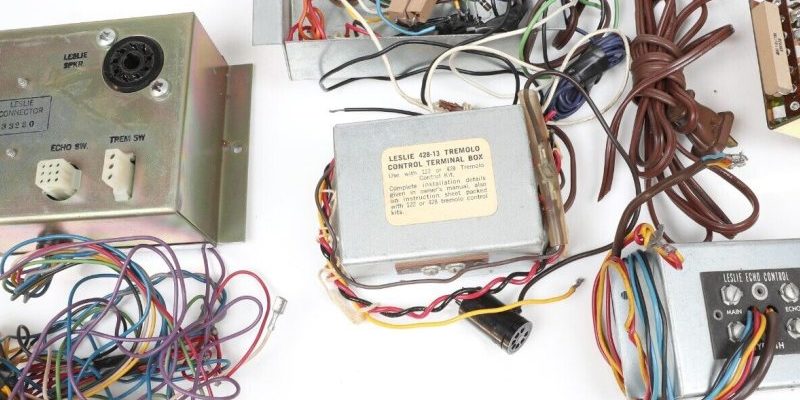Connecting to a late model Hammond™ Tonewheel Console
(Models: B2 / C2 / RT2 / B3 / C3 / RT3 / A100 / D100)
Connecting a 122 type cabinet to a B-3 or similar organ, a 6122 connector kit must be used unless you have the good fortune of having one of the old 8000 series connector kits with the half moon switches.
6122 kit In this kit, instructions are provided, but I strongly suggest removing the 6 pin socket and extending it’s leads so you can install it in the outlet box near the floor.
8000 kits With this kit the Red and Black leads to the “G” terminals of the preamp are removed from the preamp and attached to the screw terminals on top of the connector chassis. Then the Red and Black wires from the connector chassis are attached to the now vacant “G” terminals. The yellow wire from the connector kit is routed to ground, use a chassis screw. Finally, the brown lead is connected to B+ (either a special interceptor plugged into the rectifier tube’s socket, or on later kits pin 5 of the Leslie socket (6 pin sockets only).
Connecting a 147 type cabinet to a B-3 or similar organ requires some manner of control switch, and a 6 pin outlet. The outlet should be wired as indicated in the pin-out charts on the Leslie Pin-out Data page. The one question often asked is “Where do I get my audio signal?” For the 147 and all other unbalanced input Leslies the audio is derived by connect to one, AND ONLY ONE, “G” terminal on the preamp.
In this application the “Console Load Resistor” switch of the 147 should be set to “open”.
Connecting to an early model Hammond™ Console
(Models: A / B / C / D / E / BC / RT / BV / CV)
Early consoles required a high voltage called “B+” to be delivered to the preamp from the tone cabinet. When connecting to these organs, a 6 pin outlet must be used. For a 122 the additional pin is needed to return this B+ voltage. Other then that, the connection is the same as shown above.
With a 147, the procedure has an extra step. In order for the preamp to work, a substitute source for the B+ is needed. I recommend using the SE-BPLUS Power Supply from Speakeasy. (You can order from them by clicking the link.) Once installed per the instructions, you can follow the guidelines above for attaching a 147 or other unbalanced input tone cabinet.
Connecting to a Hammond Spinet Organ
(Models: M / M2 / M3 / L100 or any other organ with internal speakers)
Connecting a 122 type cabinet is possible now, with the use of a 6122 connector kit. Simply follow the provided instructions to install the kit.
Connecting a 147 type cabinet is possible by wiring a socket as outlined on the Leslie Pin-out Data page, and connecting to the speaker leads for audio. To silence the internal speakers of the organ, a load resistor can be substituted for the organ speaker (do this in the organ, and once installed select the “open” position on the console lead resistor switch in the 147).
You can also have the versatility of being able to select the speakers, or Leslie, or both, with a 6147 connector kit.
Final note on kits:
Personally I think the new kits stink. This is not a bash on Hammond Suzuki. They are using the same housing and switch design that was handed down to them by the original Leslie company who abandoned the old half-moon switches in favor of a small plastic box with horizontal toggle switches sometime in the 1970’s.
Preferring a good old fashioned half-moon switch myself, I point you to Speakeasy again who has new built connector kits with reissue half-moon switches at a reasonable price.
The other type of kit I want to mention may be a bit more contentious. That is the “transformerless” 122 kits that are out there today. Not to knock them for what they are, I have no idea how well they are or aren’t made. However, one of the chief arguments for using them is to me folly. The argument is made that because there is no transformer, you get a better tone – cleaner, purer, more holy, whatever… That may be true, but that’s the rub, the sound we all fell in love with was passed through a transformer – and it’s THAT sound, distorted or not, that we want… warts and all.
That being said, Your Mileage May Vary.

